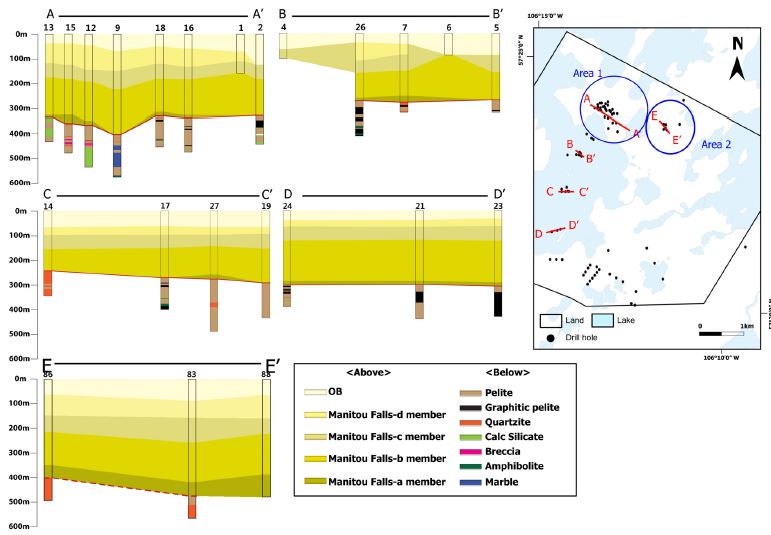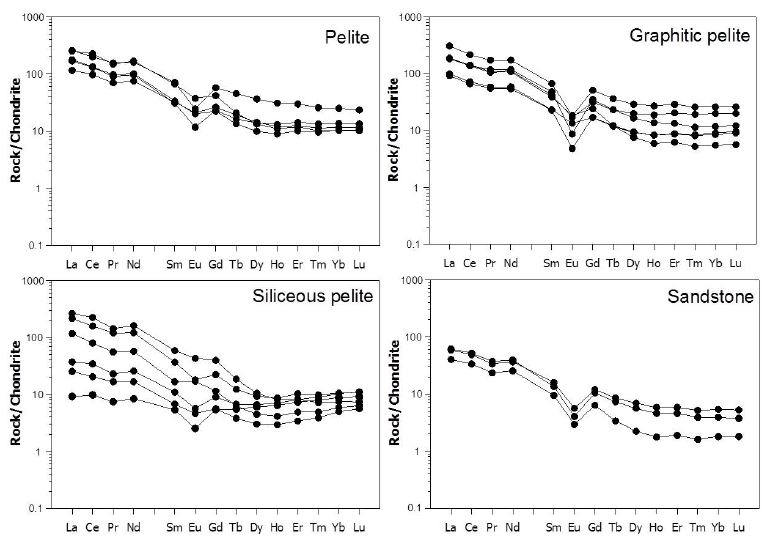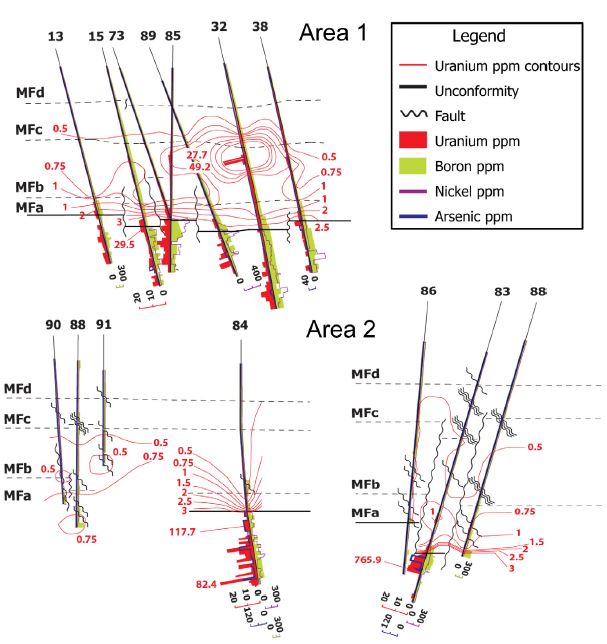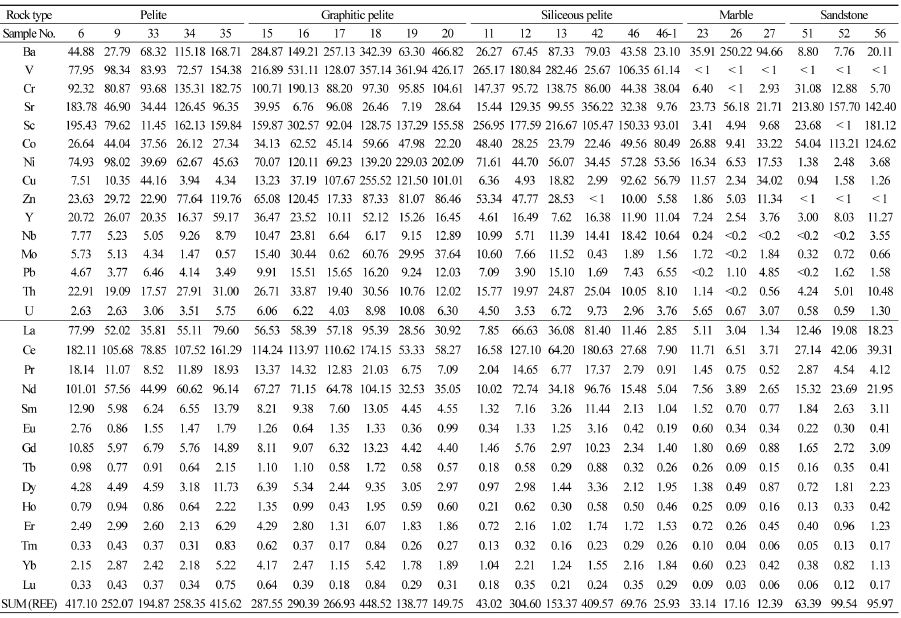
Geological and geochemical characteristics of the unconformity-related uranium mineralized zone in the Cree East area, Athabasca Basin, Canada
Geological and geochemical characteristics were investigated on the uranium mineralization zone of the Cree East area in the Athabasca Basin, Canada, which consists of upper sandstone and lower metamorphic basement rocks including pelite, graphitic pelite, siliceous pelite, quartzite, amphibolite, and marble with unconformity layer between the two. Chlorite geothermometer demonstrates that siliceous hydrothermal fluids with temperature around 200℃ is closely related to the uranium mineralization. U together with other metallic elements such as Ni, Cu, Mo, and V are mostly enriched in graphitic pelite. It is also found that there are large variations of δ34S values for sulfide minerals in graphitic pelite, –3.2 to +14.4‰, and siliceous pelite, –2.9 to +8.8‰, showing that fluid mixing occurred between two isotopically distinct fluids; basement fluid with low δ34S values and basin fluid containing a Proterozoic seawater having high δ34S values. Sudoite, which is the alteration products of illite in the sandstone or kaolinite in the basement, is found as an alteration mineral near the unconformity layer. Uranium mineralization is developed by forming a T-shape in the relation of graphitic rocks and faults in the basement and the unconformity layer. However, it is likely that the poor development of uranium ores in the study area is mostly due to the different timing of fluid activity of uranium-transporting oxidizing basinal fluids and reducing basement fluids.
초록
캐나다 아타바스카분지에 위치한 크리이스트 지역의 우라늄광화대에 대한 지질 및 지화학적 특성을 해석하였다. 연구지역은 부정합면을 중심으로 상부 사암과 하부의 이질암, 흑연질 이질암, 규질 이질암, 규암, 각섬암 및 대리암 등을 포함하는 변성암으로 구성되어 있다. 녹니석 지온계 분석결과 200℃ 내외의 온도를 갖는 규질의 열수유체가 우라늄광화작용과 밀접한 관련이 있는 것으로 보이며, 우라늄(U)과 더불어 니켈(Ni), 구리(Cu), 몰리브덴(Mo), 그리고 바나듐(V)과 같은 금속원소들이 흑연질 이질암에 두드러지게 농집되어 산출된다. 흑연질 이질암내 황화광물의 δ34S 값은 –3.2∼+14.4‰ 그리고 규질 이질암은 –2.9∼+8.8‰로서 넓은 조성범위를 보이는데 이는 기반암에서 유입된 낮은 조성을 갖는 유체와 분지에서 유입된 높은 조성을 가지는 원생대 해수와의 혼합에 의한 결과로 보인다. 변질광물로서 수도아이트(sudoite)가 부정합면 근처에 발달하는데, 이는 상부 사암층의 일라이트나 하부 기반암의 고령토가 열수변질산물로 생성된 것으로 해석된다. 우라늄 광화작용은 기반암내의 흑연질 이질암과 단층 그리고 부정합면과 관련되어 T-자 형태로 발달한다. 그러나 광체의 발달이 미약한 것은 우라늄을 함유한 분지 기원의 산화 유체와 기반암기원의 환원 유체의 활동이 시간적으로 차이가 있었기 때문인 것으로 사료된다.
Keywords:
Athabasca Basin, Unconformity-related Uranium Deposits, , Alteration, Sulfur Isotope, 아타바스카분지, 부정합관련형 우라늄광상, 열수변질, 황동위원소1. 서 언
오늘날에 들어 국제 석유가스 가격의 상승과 수요 증가로 인해 에너지원에 대한 관심과 중요성이 꾸준히 증대되고 있다. 이로 인해 많은 국가들이 안정적인 에너지 공급과 지속적인 경제성장을 위해 주요 에너지원인 우라늄광상의 탐사 및 확보에 많은 노력을 기울이고 있다. 전 세계적으로 각력암 복합체, 부정합관련형, 사암형 등 지질환경에 따라 약 15개 유형의 우라늄광상이 존재한다(IAEA, 2013). 이 가운데 부정합관련형 우라늄광상은 대부분 고기원생대 퇴적분지내에 배태되어 있으며, 오늘날 호주 노던 테리토리(Northern Territory)와 캐나다 아타바스카분지(Athabasca Basin)에서 탐사와 개발이 집중되면서 전 세계 생산량의 30% 가량을 차지하고 있다(USGS, 2012). 특히, 아타바스카분지 내 우라늄광상들은 세계 최고품위의 광상들로서 대표적으로 시가레이크(Cigar Lake) 및 맥아더리버(McArthur River)의 경우 각각 15.02%U (875 kt)와 22.28%U (1,071 kt) 품위를 나타낸다. 분지내 전체 30여개 광상의 평균 품위는 1.97%U로서 현저히 감소하지만 여전히 세계 다른 곳의 우라늄광상에 비해 고품위를 형성한다. 이곳의 우라늄광상들은 원생대 퇴적분지와 환원제 및 단층이 발달하는 시생대 혹은 고기원생대의 변성암 사이의 부정합면을 따라 발달하는 특징을 보인다(Jefferson et al., 2007).
이 지역 우라늄 광화작용에 대한 그 동안의 여러 연구결과 생성모델은 두 가지 유형으로 분류된다. 첫째는 우라늄이 사암내 인회석, 저어콘 및 모나자이트와 같은 함우라늄 광물들로부터 유래되어 파쇄대와 같은 구조적인 트랩을 따라 이동한 후 기반암에서 유래된 환원성 유체나 암석과의 반응에 의해 침전된 것으로 생각하는 것과(e.g., Wilson and Kyser, 1987; Kotzer and Kyser, 1995; Fayek et al., 1997), 다른 하나는 기반암에 함유된 우라늄이 상부의 분지나 기반암에서 유래된 유체에 의해 용탈된 후 부정합면 부근으로 이동되어 침전된 것으로 여기는 것이다(e.g., Hecht and Cuney, 2000; Derome et al., 2003). 본 연구는 국내 기업이 최근까지 컨소시움을 형성하여 우라늄탐사에 참여했던 아타바스카분지 남동부에 위치한 크리 호수(Cree Lake) 동쪽에 해당하는 크리이스트(Cree East) 우라늄광화대에 대한 지질 및 지화학적 자료를 해석하여 성인적 특성을 파악하고 아타바스카분지의 부정합관련형 우라늄광화작용의 특징을 이해하고자 하였다.
2. 지질 및 광상
2.1 광역지질 및 광상
약 85,000 km2의 면적에 해당하는 아타바스카분지는 사스카촨(Saskatchewan)주 북서부에 위치한다. 지질은 선캠브리아기 변성기반암 위에 부정합관계를 가지는 고기 내지 중기원생대에 해당하는 역질사암으로 구성된다. 아타바스카분지는 분지성장과정에서의 성장단층과 맨틀운동에 따른 광범위한 지각침하에 의해 발달된 것으로 원래 5-6 km의 층후를 이루었으나 침식에 의해 현재 최대 1.5 km 가량이 남아있다. 광상은 두 지층 사이의 부정합면을 중심으로 발달하고 있으며 대부분 분지의 동쪽 연변부에 위치한다(그림 1 ; Jefferson et al., 2007).

Simplified geologic map of the Athabasca basin in northern Saskatchewan, Canada. The position of the Cree Lake area of this study (star) and major unconformity-related uranium deposits (circle) are shown (after Jefferson et al., 2007).
사암은 95% 이상의 석영과 3% 미만의 딕카이트를 포함한 점토광물로 구성되어 있으며(Wasyliuk, 2002), 항공 및 지화학탐사 결과 우라늄은 대체로 1 ppm 미만을 보여준다(Campbell et al., 2007). 부정합면은 비교적 편평하고, 직상부에는 대부분 붉은 적철석과 고령토로 구성된 층이 발달하는데 우라늄을 함유하기도 한다. 이는 오랜 기간 지속된 속성작용 및 열수변질작용 산물로 여겨진다(Tremblay, 1982). 이러한 표층(regolith) 아래에는 녹색의 녹니석-일라이트 변질대가 놓이며 그 하부로는 신선한 기반암이 존재한다(Hoeve and Quirt, 1984). 기반암은 대부분 시생대 규장질 변성암과 고기원생대 내지 중기원생대의 규암 혹은 화강편마암 등으로 구성되어 있다. 소량의 흑연질 이질암이 단층대와 더불어 발달하기도 하는데 이는 아타바스카분지에서 가장 중요한 우라늄 배태장소로서의 역할을 한다. 주요 함우라늄 광물로는 우라니나이트, 모나자이트, 저어콘, 인회석 등이 있으며, 이들은 K, Th 및 희토류 원소들을 풍부하게 함유한다(Thomas et al., 2000).
광상은 분지 형성 이후 속성 및 열수작용에 의해 중기 원생대시기에 집중적으로 형성된 것으로 알려져 있다(Fayek et al., 2002). 광체는 우라니나이트를 주로 하는 콩깍지모양(pod), 맥상 및 반괴상 교대암체 형태로 산출되는데 이들은 부정합면을 중심으로 상부인 사암층에 배태된 유형(예, Cigar Lake 광상), 하부 기반암에 배태된 유형(예, Eagle Point 광상), 그리고 부정합면에서 하부 기반암에 걸쳐 배태된 유형(예, Dielmann 광상) 등 크게 세 가지로 구분된다(Jefferson et al., 2007). 우라늄광화작용에는 열수변질을 수반하는데 기반암에서 상부 사암으로 진행하는 유체(분출형: egress style)는 환원성 성격을 띠며 변질대 중심에서 외각으로 가면서 녹니석-수도아이트(sudoite)-일라이트 변질대가 발달하며, 분지에서 기반암을 향하는 유체(침투형: ingress style)는 산화성 유체로 일라이트-수도아이트-녹니석 변질대가 특징적으로 발달한다(Hoeve and Quirt, 1984).
2.2 크리이스트(Cree East)의 지질
크리이스트 지역은 호수가 분포하며 두껍고 편평한 퇴적층이 발달하고 있기에 하부의 지층 발달양상을 파악하기 위해 연구지역에서 획득한 91개 시추공 자료를 활용하여 단면을 제작하였다(그림 2). 부정합면의 상부는 4개로 구성된 마니토우폴(Manitou Falls) 층원(MFa-d)으로 되어있다. 이 가운데 최하부인 MFa 층원은 분급이 불량한 중립질 사암과 기질-지지(matrix-supported) 역암의 혼합층으로 구성되어 있으며, MFb는 분급이 불량한 쇄설암과 중립질 사암으로 이루어져 있다. MFc는 잔자갈 내지 왕모래로 이루어진 층과 중립내지 조립질 사암층으로 구성되며, MFd는 비교적 신선한 중립내지 조립질 사암으로 이루어져 있다. 대체적으로 각각의 층원들은 평탄한 면을 보이고 있으며 이 가운데 MFb가 가장 두꺼운 반면(최대 179 m, Hole 9), MFa는 가장 얇다(그림 2).
기반암은 이질암, 흑연질 이질암, 규질 이질암, 규암, 석회규산염암, 각섬암 그리고 대리암으로 구성된다. A-A’단면의 경우 이질암이 가장 두드러지게 산출되고 흑연질 이질암, 규질 이질암, 규암 그리고 각섬암은 부분적으로 협재된다. 또한 석회규산염암이나 대리암도 50 m 이상의 두께를 보이기도 한다. B-B’ 단면에는 이질암과 흑연질 이질암이 주를 이루며 규암과 각섬암은 소규모 분포한다. C-C’ 단면에서는 시추공 14에서 규암이 가장 많이 분포하며, 다른 시추공에서는 이질암이 주를 이루고 규암, 각섬암, 흑연질 이질암은 부분적으로 산출된다. D-D’ 단면에서는 이질암과 흑연질 이질암이 두드러지고 규암과 석회규산염암이 소량 협재된다. E-E’ 단면의 경우, 시추공 86번에는 규암만 산출되나, 83번에서는 이질암과 규암으로 구성된다. 전체적으로 보면, 이질암이 기반암의 주를 이루고 있으며, 그 밖의 다른 암석들은 부분적으로 두드러지거나 소량 협재된다.
3. 분석방법
사암과 기반암을 구성하는 5가지 암종의 67개 코어시료를 대상으로 암석기재학적 연구를 수행하였다. 전자현미분석은 한국기초과학지원연구원 전주센터의 SHIMADZU 1600을 이용하였고 분석조건은 15 kV, 10 nA, 그리고 빔직경은 1 μm 이었다. 표준시료로는 규소(Si), 알루미늄(Al)은 남정석, 철(Fe)은 황철석, 칼륨(K)은 정장석, 칼슘(Ca)은 규회석, 나트륨(Na)은 조장석, 망간(Mn)은 장미휘석, 티타늄(Ti)는 금홍석, 마그네슘(Mg)은 MgO, 그리고 인(P)은 인회석을 사용하였다. 희토류 및 희유원소분석을 위해 이질암(n=5), 흑연질 이질암(n=6), 규질 이질암(n=6), 대리암(n=3), 그리고 사암(n=3)에서 총 23개 시료를 선정하여 한국기초과학지원연구원의 Optima 4300DV과 Elan 6100를 이용하여 ICP-MS/ AES 분석을 수행하였다.
대부분이 황철석으로 구성된 황화광물의 황안정동위원소분석을 위해 흑연질 이질암과 규질 이질암의 분말 시료 14개를 대상으로 Ueda and Krouse (1986) 방법을 따라 SO2 가스를 준비하고 한국기초과학지원연구원의 ISOPRIME 질량분석기를 이용하여 분석을 수행하였다. 분석오차는 ±0.2‰ 이내이다. 심도별 점토광물의 변화양상을 파악하기 위해 13개 시추코어를 대상으로 휴대용 분광계(TerraSpec)로 스캔하여 측정하고, 각각의 점토광물(고령토, 딕카이트, 일라이트, 녹니석, 수도아이트)과 드라바이트(dravite)의 함량비를 TSG-Pro 소프트웨어를 활용하여 구하였으며, XRD와 SEM을 보조적으로 사용하였다. 이는 연구지역 조사기관인 CanAlaska Uranium Ltd.에서 수행하였다. 또한 이들 코어 시료를 대상으로 우라늄(U)을 비롯해 니켈(Ni), 비소(As), 그리고 붕소(B)와 같은 다른 희유원소의 심도별 변화를 파악하기 위해 밴쿠버 ACME Lab에서 ICP-AES 분석을 수행하였다.
4. 암석기재학
이질암은 석영, 흑운모, 정장석과 더불어 녹니석, 고령토 등이 종종 수반되고(그림 3a, 3b), 황철석, 방연석 등의 황화광물이 미량 산출된다. 흑연질 이질암은 석영, 금운모, 백운모, 녹니석, 및 고령토와 더불어 탄질물질도 다량 포함한다. 흑운모는 관찰되지 않으며, 황철석은 최대 1 cm 가량의 크기로 반자형 형태로 흔히 산출된다(그림 3c, 3d, 3e). 파쇄대 부근에 흔히 산출되는 규질 이질암은 각력조직이 발달하며 석영, 녹니석, 일라이트, 고령토, 백운모, 인회석 및 돌로마이트 등으로 구성되어 있다(그림 3f, 3g). 황철석은 수 mm 까지 다양한 크기로 타형을 이루며 산출된다. 거정질의 돌로마이트로 구성된 대리암은 분홍 내지 붉은 색을 띠고 세 방향 벽개가 잘 발달된 모자이크 형태를 이루고 있으며(그림 3h), 소량의 석영, 흑운모 및 녹니석도 관찰된다. 사암은 대부분 반자형의 석영이 90% 이상을 차지하며, 소량의 일라이트, 딕카이트, 적철석, 능철석이 수반된다(그림 3i). 이 밖에 변질된 사암에서는 APS (aluminum phosphate-sulfate) 광물의 일종인 비비아나이트(vivianite)가 미량 산출되는 것으로 보고된 바 있다(CanAlaska Uranium Ltd., 2008).

Microphotographs of various rock types in the study area. a-b: pelite, c-e: graphitic pelite, f-g: siliceous pelite, h: marble, i: sandstone. Abbreviations: Qz (Quartz), Bt (Biotite), Or (Orthoclase), Mu (Muscovite), Il (Illite), Phl (phlogopite), Ka (kaolinite), Chl (chlorite), Dol (Dolomite), Py (Pyrite), Co (Coaly material).
5. 광물화학
녹니석은 이질암, 흑연질 이질암, 규질 이질암 그리고 대리암에서 관찰되며 SiO2 함량은 각각 27.20∼30.00 wt%, 23.77∼24.64 wt%, 35.17∼36.50 wt%, 그리고 27.89∼29.30 wt%를 갖는다(표 1). 이들을 Hey’s diagram (1954)에 도시한 결과 이질암은 클리노클로어(clinochlore), 피크노클로라이트(pycnochlorite), 그리고 브런비자이트(brunsvigite)에 해당하고(Si=5.66∼5.83, Fe/(Fe+Mg)=0.23∼0.62). 흑연질 이질암은 리피돌라이트(ripidolite) (Si=5.23∼5.37, Fe/(Fe+Mg)=0.65∼0.66), 규질 이질암은 페니나이트(penninite) (Si=6.45∼6.54, Fe/(Fe+Mg)= 0.07∼0.08), 그리고 대리암은 클리노클로어와 쉐리다나이트(sheridanite) (Si=5.41∼5.68, Fe/(Fe+Mg)= 0.06∼0.08)에 해당한다(그림 4).
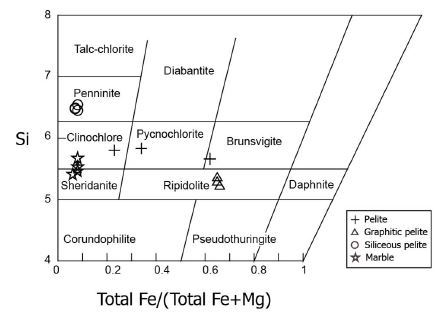
Compositions of chlorite in pelite, graphitic pelite, siliceous pelite and marble plotted on Hey's diagram (1954).
녹니석 지질온도계(Zang and Fyfe, 1995)를 이용하여 이들의 생성온도를 추정한 결과 이질암은 239∼261℃, 흑연질 이질암은 269∼282℃, 그리고 대리암은 288∼318℃의 범위를 보이는 반면, 열수작용과 밀접한 관련이 있는 규질 이질암은 이들보다 현저히 낮은 197∼206℃를 나타낸다. 아타바스카분지 우라늄광화작용에 대한 기존 연구결과를 살펴보면 맥아더리버(McArthur River) 광상의 경우 녹니석 지질온도계는 150∼240℃(Ng et al., 2013b) 그리고 유체포유물은 140∼200℃(Derome et al., 2005)의 범위를 보여주며, 키레이크(Key Lake) 광상은 안정동위원소 지질온도계로 추정한 결과 190∼230℃(Wilson and Kyser, 1987)로 나타난 바 있어서 연구지역인 크리이스트 지역 규질 이질암에서 산출되는 녹니석 지질온도계와 유사하다. 이러한 결과는 연구지역 우라늄광화작용에 관여한 규질의 열수용액이 기반암에 침투하여 약 200℃ 내외에서 열수변질작용을 일으켰음을 시사하는 것으로 보인다.
6. 지화학적 특성
6.1 희유 및 희토류 원소
ICP-MS/AES에 의한 암종별 희유 및 희토류 원소분석결과는 표 2에 제시되어 있다. 우라늄의 경우 흑연질 이질암은 6.94 ppm, 이질암은 3.42 ppm, 규질 이질암은 5.20 ppm, 대리암은 3.13 ppm, 그리고 사암은 0.82 ppm으로서 흑연질 이질암이 가장 높은 함량을 갖는다. 또한 니켈(Ni), 구리(Cu), 몰리브덴(Mo), 그리고 바나듐(V) 등의 금속원소들도 흑연질 이질암에서 가장 높은 함량을 보이는 반면 대리암과 사암에서 가장 적게 나타난다. 우라늄과 금속원소들의 함량을 상호 도시한 결과 정의 상관관계를 보여주는데(그림 5) 이는 우라늄 광화작용 시에 여러 금속원소들이 함께 수반되었음을 시사하는 것이다.
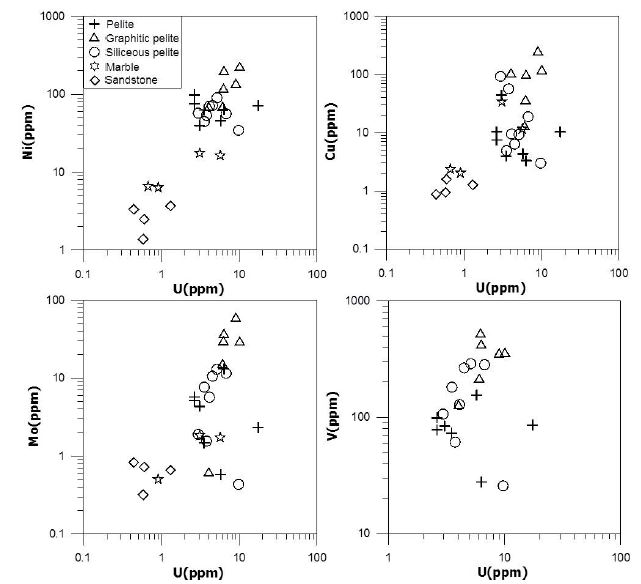
Correlation diagram of U and metallic elements for pelite, graphitic pelite, siliceous pelite, marble, and sandstone.
희토류원소들을 콘드라이트(Boynton, 1984)로 표준화한 스파이더 다이어그램이 변성작용 및 열수변질작용의 특성을 파악하는데 유용한 것으로 알려져 왔다(Hecht et al., 1999). 연구지역 시료를 도시한 결과 대부분의 암석에서 경희토류(LREE)가 부화되고 부의 유로퓸(Eu) 이상이 발달하는 특징을 잘 보여주는데(그림 6), 이러한 특징은 쇄설성퇴적암의 표준시료로 활용되는 북미셰일복합체(North American Shale Composite)나 후시생대평균호주퇴적암(Post-Archaean average Australian sedimentary rock)과 매우 유사하다(Gromet et al., 1984; McLennan, 1989). 특히, 이질암과 흑연질 이질암은 희토류 함량 및 변화양상이 상호 유사한 반면, 규질 이질암은 다소 교란되어 나타나는데, 일부 시료에서 경희토류(LREE)가 다른 시료에 비해 상당히 결핍되고, 유로퓸(Eu) 이상이 미약하게 나타난다. 반면 사암의 경우 전체적인 희토류 함량이 이질암에 비해 적게 나타난다(<100 ppm). 규질 이질암에서 이러한 특징을 보이는 이유는 희토류 함량이 현저히 적은 상부 사암으로부터 유래된 열수유체가 하부 기반암에 유입되어 나타난 결과로 볼 수 있다.
6.2 황안정동위원소
흑연질 이질암에 포함된 황화광물의 δ34S 값은 –3.2∼+14.4‰, 규질이질암은 –2.9∼+8.8‰로서 비교적 넓은 조성범위를 갖는다(표 3). 아타바스카분지 우라늄광화작용에 관여한 광화유체의 기원과 관련 Kotzer and Kyser (1995)는 상부에서 유입된 염수는 천수의 영향을 크게 받았고, 또한 증발암의 용해와 장석과의 반응에 의해 광화유체의 염소 함량이 높게 나타나는 것으로 해석하였다. 또한 Alexandre et al. (2005)은 동위원소연구를 통해 광화유체는 해수와 천수와의 혼합에 의해 생성된 것으로 보고하였다. Richard et al. (2011)도 유체포유물의 Cl/Br비와 Cl 동위원소조성을 통해 광화유체가 대부분 해수기원이었음을 제시하였다.
그 동안의 연구결과 아바타스카분지내 부정합관련형 우라늄광상들은 상부 사암으로부터 유래된 고염농도, 산화성 그리고 비교적 산성의 염수와 하부 기반암에서 유래된 환원성 유체와의 상호작용에 의해 형성된 것으로 알려져 왔다(Hoeve and Quirt, 1984; Ng et al., 2013a). 이로 보아 연구지역 황화광물의 넓은 δ34S 조성 범위는 서로 다른 기원의 두 유체 즉, +14‰ 이상의 조성을 가지는 원생대 해수기원의 상부 유체가 기반암으로 유입되어 -3‰ 이하의 조성을 가지는 유체와 혼합하여 형성된 것으로 보인다. 또한 상대적으로 낮은 δ34S 값을 보이는 흑연질 이질암은 보다 환원환경이었음을 시사하고, 반면 규질 이질암이 높은 조성을 보이는 것은 황산염광물이 풍부한 분지에서 유래된 규질의 열수유체가 기반암과 반응한 결과로 해석된다(Kotzer and Kyser, 1995; Alexandre et al., 2009).
6.3 심도별 변질광물과 희유원소 변화
변질양상이 서로 다른 두 지역의 변질광물군을 비교 분석하였다(그림 7). Area 1에서 딕카이트와 일라이트가 부정합면 상부에서 주변질광물로 산출되며, 소량의 고령토, 녹니석, 수도아이트 및 드라바이트가 수반된다. 기반암에서는 고령토, 일라이트, 녹니석, 수도아이트, 펜자이트(phengite) 및 소량의 드라바이트가 산출된다. 특히 수도아이트의 경우 대부분의 시추공에서 부정합면 직상부에 두드러지게 발달한다. Area 2의 사암층에서는 일라이트와 고령토가 주를 이루며, 수도아이트는 MFc 층원을 따라 주로 분포하는 특징을 보여준다. 시추공 84의 경우는 상부 사암층이 대부분 딕카이트와 일라이트로 구성되어 있어서 Area 1과 유사한 양상을 나타낸다. 시추공 86과 88에는 상부 사암에서 딕카이트와 드라바이트가 각각 소량 검출된다. 기반암에서는 특히 시추공 83과 84에서 일라이트, 녹니석, 그리고 고령토가 주된 점토광물로 산출되며, 소량의 딕카이트와 펜자이트가 시추공 83과 86에서 수반된다. 시추공 84에서는 Area 1과 유사하게 부정합면 근처에 수도아이트가 산출된다.
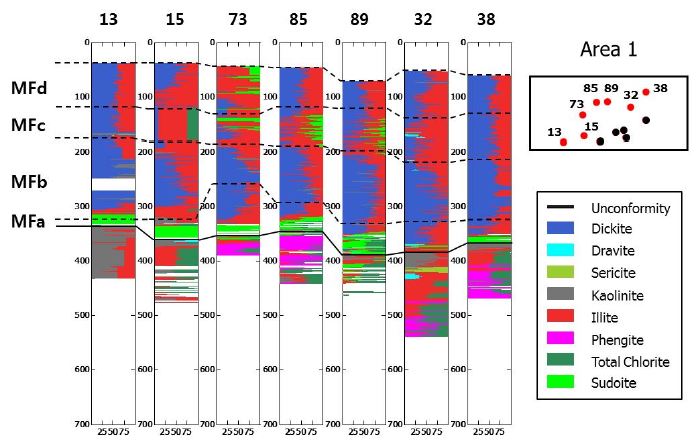
Vertical variations of clay minerals for boreholes in Area 1 & 2. Abbreviation: MF=Manitou Falls Formation.
기존 연구결과 수도아이트는 아타바스카분지의 우라늄광화작용과 밀접한 관련이 있는 것으로 확인되었다(Percival and Kodama, 1989; Kupsch and Catuneaun, 2001; Ng et al., 2013b). 시가레이크(Cigar Lake) 광상의 경우 우라늄광체 주변 변질대에는 다량의 수도아이트가 산출되는 것으로 나타나며, 이는 일라이트나 고령토의 열수변질산물로 해석되었다(Percival and Kodama, 1989). 따라서 연구지역 Area 1에서와 같이 부정합면을 따라 수도아이트가 연속적으로 산출되는 것은 시가레이크 광상과 같이 상부 사암층을 구성하는 일라이트나 하부 기반암의 고령토가 열수변질과정을 거치면서 형성된 것으로 여겨진다. 아타바스카분지에서 변질광물로 산출되는 드라바이트는 마그네슘(Mg)과 붕소(B)가 농집된 증발된 해수 기원의 염수가 유입된 결과로 알려져 있다(Mercadier et al., 2012; Ng et al., 2013a). 그러나 쇄설성 기원의 전기석이 상부 사암(Rosenberg and Foit, 2006)이나 하부 기반암(Mercadier et al., 2012)에 산출하는 것으로 알려져 있어서 이들이 변질기원 드라바이트 형성에 관여했을 가능성도 있다.
변질광물군 변화양상을 측정한 시추코어를 대상으로 우라늄과 다른 금속원소들의 심도별 변화양상을 파악한 결과 이들 원소들의 함량은 변화폭이 있으나 부정합면 아래의 기반암에 현저히 농집된 양상을 보여준다(그림 8). 기반암에서의 우라늄함량은 대체로 수 십 ppm 내지 곳에 따라서는 수 백 ppm에 이르는 반면, 상부 사암층에서는 3 ppm 미만으로 나타난다. 예외적으로 시추공 32에서는 상부 사암에서 49 ppm에 이르는 우라늄 이상대가 발달하기도 하지만 이 경우 기반암에서도 우라늄 농집이 두드러진다. 우라늄 농집은 단층대와 밀접한 관련이 있어 보인다. Area 2에서 시추공 86과 83 사이에 대규모 수직변위가 존재하는데 시추공 83의 기반암에서 766 ppm에 해당하는 우라늄이 농집된 결과를 보여주며, 이와 동시에 붕소(B), 니켈(Ni), 및 비소(As) 등의 금속원소들도 상당히 부화된 양상을 나타낸다. Area 1에서는 Area 2보다는 미약하지만 시추공 사이사이에 수직변위가 매우 흔하게 발달하고 있으며, 시추공 84의 경우 주변에 단층대가 발달하지 않지만 기반암에서 우라늄(U) (최대 117 ppm), 니켈(Ni), 비소(As), 및 붕소(B) 등의 원소들이 부화된 특징을 보여준다. 전체적으로 우라늄은 대부분 단층을 수반하는 기반암 내부나 부정합면을 따라 농집된 경향이 두드러지며, 하부 기반암에서 우라늄 함량이 높더라도 동일 시추공의 상부 사암층에서의 우라늄산출은 미미하게 나타난다(예, Hole 83, 84).
7. 우라늄광화작용
열수용액에 포함된 우라늄 이온은 환원상태에서는 우라늄 6가 이온(U6+)이 우라늄 4가 이온(U4+)으로 전환되며 UO2 형태로 침전된다. 연구지역에서 열수유체가 흑연을 포함하는 변성퇴적암을 만나게 되면 우라늄이온이 흑연질 암석에 흡착되어 우라늄광체를 형성하게 된다. 연구지역 수도아이트는 기반암에서 상승한 열수유체에 의해 부정합면 부근에서 일라이트나 고령토의 변질반응 산물로 생성되는데 부정합면은 대단히 다공질로서 투수율이 높기 때문에 유체의 이동과 그에 따른 변질작용이 활발히 일어나게 된다(Mwenifumbo et al., 2007). 또한 상부 사암에서도 일라이트가 상당히 발달한 것으로 나타나는데 이로 보아 연구지역 열수변질대 유형이 Hoeve and Quirt (1984)가 제시한 분출형(egress style)에 가까운 것으로 여겨진다.
황안정동위원소와 희토류원소 연구결과에서도 하부기반암으로 분지기원의 유체 유입이 있었던 것으로 보아 우라늄을 함유한 분지기원 산화성 유체가 기반암으로 유입된 후 단층대를 따라 상승하면서 우라늄광물을 정출시킨 것으로 보인다. 광체의 발달은 부정합면과 상부 사암에 집중된 시가레이크(Cigar Lake)형 우라늄광상과는 달리 연구지역은 부정합면과 직하부 단층대를 따라 발달하여 우라늄과 더불어 여러 금속원소들이 부화된 T-형의 광체를 형성한 것으로 나타난다. 이러한 특징은 아타바스카분지내 우라늄 광상의 세 가지 유형 중 디엘만(Dielmann)형에 가까운 것으로 보인다(Jefferson et al., 2007).
그러나 연구지역에서는 아타바스카분지내 다른 우라늄광상에서 흔히 발달하는 열수변질대가 사암층과 기반암 모두에서 형성되어 있으나 두드러진 부광대를 이룬 곳은 아직까지 발견되지 않았다. 기존 연구결과에 따르면 아타바스카분지내 부정합관련형 우라늄광상에서는 우라늄을 함유한 산화성 분지기원 유체가 기반암에서 유래된 환원성 유체와 반응하여 우라늄을 침전한 것으로 알려져 왔으나(Kotzer and Kyser, 1995; Fayek et al., 1997; Kyser et al., 2000), 만약, 대규모의 산화성 및 환원성 유체가 동시에 형성되지 않는다면 변질대의 발달에도 불구하고 우라늄광물이 정출되지 않는 것으로 밝혀졌다(Alexandre et al., 2009; Cloutier et al., 2010). 연구지역의 경우 사암층에서 일라이트가 풍부한 변질대가 발달하여 산화성 유체의 강한 활동이 있었음을 시사하고, 반면 기반암에서는 녹니석과 관련된 환원성 유체활동이 두드러진 것으로 나타났으나, 이 두 유체의 활동이 시간적으로 차이가 있었던 것이 크리이스트지역에서 경제성 있는 우라늄광체 발달이 미약한 이유로 여겨진다.
8. 결 론
아타바스카분지내 크리이스트(Cree East) 일대 지질은 부정합면을 중심으로 네 개의 층원으로 구성된 상부의 사암층과 이질암, 흑연질 이질암, 규질이질암, 규암 및 대리암 등으로 이루어진 하부 기반암으로 이루어져있다. 이 가운데 규질 이질암내 녹니석 지온계가 낮은 온도범위(197∼206℃)를 나타내고, 희토류 함량변화 폭이 크게 나타나는 등 교란된 양상을 보이는 것은 규질의 열수용액의 유입과 더불어 우라늄광화작용이 진행되었음을 시사한다. 우라늄(U)과 니켈(Ni), 구리(Cu), 몰리브덴(Mo), 및 바나듐(V) 등의 다른 금속원소들이 흑연질 이질암에 가장 많이 부화되어 있으며 이들은 상호 정의 상관관계를 형성하는데 이는 우라늄 광화작용시 이들 금속원소들이 함께 수반되었음을 나타낸다. 흑연질 이질암과 규질 이질암의 황동위원소 조성은 각각 –3.2∼+14.4‰과 –2.9∼+8.8‰에 해당하고 이러한 넓은 조성범위를 보이는 것은 서로 다른 기원의 두 유체 즉, +14‰ 이상의 조성을 가지는 해수기원의 상부 유체와 –3‰ 이하의 조성을 가지는 기반암 기원의 유체와 혼합하여 형성된 것으로 보인다. 아울러 아타바스카분지 우라늄광화작용과 밀접한 관련이 있는 것으로 알려진 수도아이트가 부정합면 부근에 연속적으로 발달하는데 이는 상부 사암층의 일라이트나 하부 기반암의 고령토가 열수변질을 받아 생성된 것으로 해석된다. 그러나 광체 발달이 미약한 것은 우라늄을 수반한 산화성 분지기원 유체와 기반암에서 유래된 환원성 유체의 활동이 시간적으로 차이가 있었기 때문인 것으로 여겨진다.
Acknowledgments
본 연구는 2012년도 산업통상자원부의 재원으로 한국에너지기술평가원(KETEP)의 에너지자원기술개발사업의 지원을 받아 수행된 결과임(No. 20102010 30003A). 본 논문을 심사해 주시고 유익한 비평을 주신 고려대학교 이영재 교수님과 두 분의 익명의 심사위원께 감사드립니다.
References
-
P Alexandre, K Kyser, P Polito, D Thomas, Alteration Mineralogy and Stable Isotope Geochemistry of Paleoproterozoic Basement-Hosted Unconformity-Type Uranium Deposits in the Athabasca Basin, Canada, Economic Geology, (2005), 100, p1547-1563.
[https://doi.org/10.2113/gsecongeo.100.8.1547]

-
P Alexandre, K Kyser, D Jiricka, Critical Geochemical and Mineralogical Factors for the Formation of Unconformity-Related Uranium Deposits: Comparison between Barren and Mineralized Systems in the Athabasca Basin, Canada, Economic Geology, (2009), 104, p413-435.
[https://doi.org/10.2113/gsecongeo.104.3.413]

-
W.V Boynton, Cosmochemistry of rare earth elements: meteorite studies. In: Henderson, P. (ed.) Rare earth element geochemistry, Elsevier, (1984), p63-114.
[https://doi.org/10.1016/B978-0-444-42148-7.50008-3]

- J.E Campbell, R.A Klassen, R.B.K Shives, Integrated field investigations of airborne radiometric data and drift composition, Nuclear Energy Agency.-International Atomic Energy Agency Athabasca test area, Saskatchewan. In: Jefferson, C.W. and Delaney, G. (ed.) EXTECH IV: Geology and Uranium Exploration TECHnology of the Proterozoic Athabasca Basin, Saskatchewan and Alberta, Geological Survey of Canada Bulletin 588, (2007), p533-554.
- CanAlaska Uranium Ltd, Identification of dark blue mineral (vivianite) Cree East Project, Northern Saskatchewan. Report by Laramide Petrologic Services, 5, (2008).
-
J Cloutier, K Kyser, G.R Olivo, P Alexandre, Contrasting patterns of alteration at the Wheeler River area, Athabasca Basin, Saskatchewan, Canada: Insight into the apparently uranium-barren zone K alteration system, Economic Geology, (2010), 105, p303-324.
[https://doi.org/10.2113/gsecongeo.105.2.303]

- D Derome, M Cathelineau, T Lhomme, M Cuney, Fluid inclusion evidence of the differential migration of H2 and O2 in the McArthur River unconformity-type uranium deposit (Saskatchewan, Canada): Possible role on post-ore modifications of the host rocks, Journal of Geochemical Exploration, (2003), p78-79, 525-530.
-
D Derome, M Cathelineau, M Cuney, C Fabre, T Lhomme, Mixing of sodic and calcic brines and uranium deposition at McArthur River, Saskatchewan, Canada: A raman and laser-induced breakdown spectroscopic study of fluid inclusions, Economic Geology, (2005), 100, p1529-1545.
[https://doi.org/10.2113/gsecongeo.100.8.1529]

-
M Fayek, J Janeczek, R.C Ewing, Mineral chemistry and oxygen isotopic analyses of uraninite, pitchblende and uranium alteration minerals from the Cigar Lake deposit, Saskatchewan, Canada, Applied geochemistry, (1997), 12, p549-565.
[https://doi.org/10.1016/S0883-2927(97)00032-2]

-
M Fayek, T.K Kyser, L.R Riciputi, U and Pb isotope analysis of uranium minerals by ion microprobe and the geochronology of the McArthur River and Sue Zone uranium deposits, Saskatchewan, Canada, The Canadian Mineralogist, (2002), 40, p1553-1569.
[https://doi.org/10.2113/gscanmin.40.6.1553]

-
L.P Gromet, R.F Dymek, L.A Haskin, R.L Korotev, The 'North American shale composite' - Its compilation, major and trace element characteristics, Geochimica et Cosmochimica Acta, (1984), 48, p2469-2482.
[https://doi.org/10.1016/0016-7037(84)90298-9]

-
L Hecht, M Cuney, Hydrothermal alteration of monazite in the Precambrian crystalline basement of the Athabasca Basin (Saskatchewan, Canada): Implications for the formation of unconformity-related uranium deposits, Mineralium Deposita, (2000), 35, p791-795.
[https://doi.org/10.1007/s001260050280]

- L Hecht, R Freiberger, H.A Gilg, G Grundmann, Y.A Kostitsyn, Rare earth element and isotope (C, O, Sr) characteristics of hydrothermal carbonates: genetic implications for dolomite-hosted talc mineralization at Göpfersgrün (Fichtelgebirge, Germany), Chemical Geology, (1999), 155, p115-130.
-
M.H Hey, A new review of the chlorites, Mineralogical Magazine, (1954), 30, p277-292.
[https://doi.org/10.1180/minmag.1954.030.224.01]

- J Hoeve, D.H Quirt, Mineralization and host rock alteration in relation to clay mineral diagenesis and evolution of the middle-Proterozoic, Athabasca Basin, northern Saskatchewan, Canada, Saskatchewan Research Council, SRC Technical Report 187, (1984).
- IAEA, World distribution of uranium deposits. Website://www.IAEA.org//UDEPOreports, (2013).
- C.W Jefferson, D.J Thomas, S.S Gandhi, P Ramaekers, G Delaney, D Brisbin, C Cutts, P Portella, R.A Olson, Unconformity-associated uranium deposits of the Athabasca Basin, Saskatchewan and Alberta. In: Jefferson, C.W. and Delaney, G. (ed.) EXTECH IV: Geology and Uranium Exploration TECHnology of the Proterozoic Athabasca Basin, Saskatchewan and Alberta, Geological Survey of Canada Bulletin 588, (2007), p23-68.
- T.G Kotzer, T.K Kyser, Petrogenesis of the Proterozoic Athabasca basin, northern Saskatchewan, and its relation to diagenesis, hydrothermal uranium mineralization and paleohydrology, Chemical Geology, (1995), 120, p45-89.
- B.G Kupsch, O Catuneaun, Alteration features and geochemical signatures of the Maybelle River uranium zone, Athabasca Basin, Alberta. In: Jefferson, C.W. and Delaney, G. (ed.) EXTECH IV: Geology and Uranium EXploration TECHnology of the Proterozoic Athabasca Basin, Saskatchewan and Alberta, Geological Survey of Canada Bulletin 588, (2001), p347-361.
- K Kyser, E Hiatt, C Renac, K Durocher, G Holk, K Deckart, Diagenetic fluids in Paleo- and Mesoproterozoic sedimentary basins and their implications for long protracted fluid histories, In: Kyser, K. (ed.) Fluids and Basin Evolution. Mineralogical Association of Canada, Short Course Series, (2000), 28, p225-262.
- S.M McLennan, Rare earth elements in sedimentary rocks; influence of provenance and sedimentary processes. In: Lipin, B.R. and McKay, G.A. (ed.), Geochemistry and mineralogy of rare earth elements, Reviews in Mineralogy and Geochemistry, (1989), 21, p169-200.
- J Mercadier, A Richard, M Cathelineau, Boron- and magnesium-rich marine brines at the origin of giant unconformity-related uranium deposits: δ11B evidence from Mg-tourmalines, Geology, (2012), 40, p231-234.
- C.J Mwenifumbo, J.B Percival, G.R Bernius, B Elliott, C.W Jefferson, K Wasyliuk, G Drever, Comparison of geophysical, mineralogical, and stratigraphic attributes in drillholes MAC-218 and RL-88, McArthur River uranium camp, Athabasca Basin, Saskatchewan. In: Jefferson, C.W. and Delaney, G. (ed.) EXTECH IV: Geology and Uranium EXploration TECHnology of the Proterozoic Athabasca Basin, Saskatchewan and Alberta, Geological Survey of Canada Bulletin 588, (2007), p507-520.
-
R Ng, P Alexandre, K Kyser, Mineralogical and Geochemical Evolution of the Unconformity-Related McArthur River Zone 4 Orebody in the Athabasca Basin, Canada: Implications of a Silicified Zone, Economic Geology, (2013a), 108, p1657-1689.
[https://doi.org/10.2113/econgeo.108.7.1657]

-
R Ng, P Alexandre, K Kyser, J Cloutier, Y.A Abdu, F.C Hawthorne, Oxidation state of iron in alteration minerals associated with sandstone-hosted unconformity-related uranium deposits and apparently barren alteration systems in the Athabasca Basin, Canada: Implications for exploration, Journal of Geochemical Exploration, (2013b), 130, p22-43.
[https://doi.org/10.1016/j.gexplo.2013.02.009]

- J.B Percival, H Kodama, Sudoite from Cigar Lake, Saskatchewan, The Canadian Mineralogist, (1989), 27, p633-641.
- A Richard, D.A Banks, J Mercadier, M.C Boiron, M Cuney, M Cathelineau, An evaporated seawater origin for the ore-forming brines in unconformity-related uranium deposits (Athabasca Basin, Canada): Cl/Br and δ37Cl analysis of fluid inclusions, Geochimica et Cosmochimica Acta, (2011), 75, p2792-2810.
-
P.E Rosenberg, F.F Foit Jr, Magnesiofoitite from the uranium deposits of the Athabasca basin, Saskatchewan, Canada: Canadian Mineralogist, (2006), 44, p959-965.
[https://doi.org/10.2113/gscanmin.44.4.959]

- D.J Thomas, R.B Matthews, V Sopuck, Athabasca Basin (Canada) unconformity-type uranium deposits: exploration model, current mine developments and exploration directions; In: Cluer, J.K., Price, J.G., Struhsacker, E.M., Hardyman, R.F. and Morris, C.L. (ed.) Geology and Ore Deposits 2000: The Great Basin and Beyond, Geological Society of Nevada Symposium Proceedings, Reno, Nevada, (2000), p103-206.
- L.P Tremblay, Geology of the uranium deposits related to the sub-Athabasca unconformity, Saskatchewan, Geological Survey of Canada, Paper 81-20, (1982), p56.
-
A Ueda, H.R Krouse, Direct conversion of sulphide and sulphate minerals to SO2 for isotope analyses, Geochemical Journal, (1986), 20, p209-212.
[https://doi.org/10.2343/geochemj.20.209]

- USGS, Critical analysis of world uranium resources. Scientific investigations report 2012-5239, (2012).
- K Wasyliuk, Petrogenesis of the kaolinite-group minerals in the eastern Athabasca Basin of northern Saskatchewan: Applications to uranium mineralization, MSc, Thesis: University of Saskatchewan, Saskatoon, Saskatchewan, (2002), p140.
-
M.R Wilson, T.K Kyser, Stable isotope geochemistry of alteration associated with the Key Lake uranium deposit, Canada, Economic Geology, (1987), 82, p1540-1557.
[https://doi.org/10.2113/gsecongeo.82.6.1540]

- W Zang, W.S Fyfe, Chloritization of the hydrothermally altered bedrock at the Igarape Bahia gold deposit, Carajas, Brazil, Mineralium Deposita, (1995), 30, p30-38.
